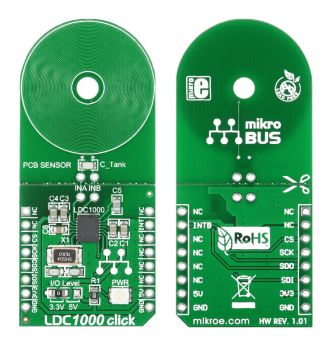
We strongly encourage users to use Package manager for sharing their code on Libstock website, because it boosts your efficiency and leaves the end user with no room for error. [more info]

Rating:
Author: MIKROE
Last Updated: 2018-11-07
Package Version: 1.0.0.1
mikroSDK Library: 1.0.0.0
Category: Inductance
Downloaded: 7814 times
Followed by: 2 users
License: MIT license
LDC1000 click carries the world's first inductance-to-digital converter IC. The board is ideal for highly precise short range measurements of the position, motion or composition of conductive targets.
Do you want to subscribe in order to receive notifications regarding "LDC1000 click" changes.
Do you want to unsubscribe in order to stop receiving notifications regarding "LDC1000 click" changes.
Do you want to report abuse regarding "LDC1000 click".
